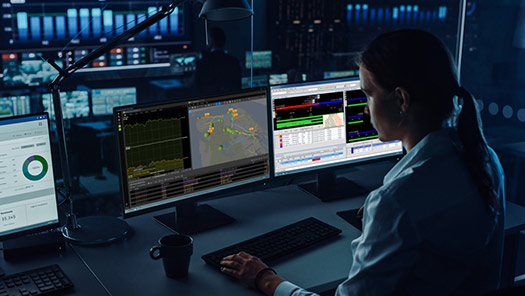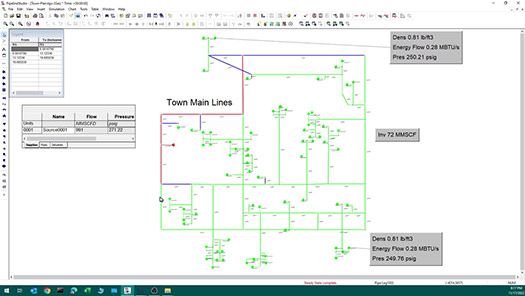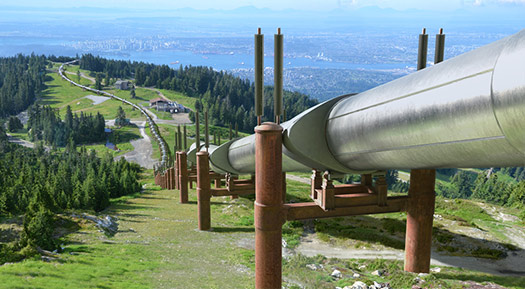October 2023, Vol. 250, No. 10
Features
Embracing Sustainability Across Pipelines Requires Digital Transformation
By Julie Hatfield, Senior Director, Emerson, and Ron Beck, Senior Director, AspenTech
(P&GJ) — The environment in which pipelines must operate is changing rapidly and dramatically, as constant shifts in the global marketplace have underscored a need for increasing flexibility.
For example, many midstream operators are strategically evaluating the opportunities to convert pipelines to transportation of hydrogen and carbon dioxide (CO2). Today, some natural gas distribution companies are looking at the feasibility of mixing up to 20% hydrogen into their existing pipeline networks. To accomplish this, teams must be more flexible in both their operation and monitoring.
However, that need for flexibility is arriving just as experienced personnel retire in droves, and new staff members are becoming harder to find and retain. Add to those challenges an increasing international requirement for more sustainable operations and a need for more cybersecurity from the field to the control room, and it can quickly start to feel as though pipeline operators will never catch up.
Fortunately, just as operations become more complex, digitalization is evolving at a record pace to meet these new needs.
Today’s best industrial digitalization solutions are helping teams digitally transform their pipeline operations to better support changing needs and dynamics across their fleets. The organizations that embrace this transformation will be positioned to meet that future head-on, more easily navigating the complexity, security, and regulatory issues that will arise as the marketplace shifts to meet expectations.
New needs
One of the key driving factors behind the need for more flexibility in pipeline operations is the increased global call from both the public and investors for more sustainable energy production. Corporate entities are not only striving to meet these goals, but are doing so publicly, typically by announcing commitments to reach net zero emissions within the next ten to twenty years.
However, setting net zero sustainability goals and actually meeting them are two vastly different things, and the latter effort typically falls on operations and maintenance teams for planning and execution. At the heart of successful execution of more sustainable operations and maintenance is good data that provides comprehensive visibility to what is happening across the pipeline – a goal that is becoming more challenging as experienced personnel become scarcer.
Today, many organizations track their CO2 emissions on spreadsheets, a task they complete quarterly or even annually. Often, this results in teams not having a clear picture until the end of the year as to whether they met their commitments or not. And if they did not meet their commitments, they go into the next year behind the curve and typically fall further and further behind as part of a continuous cycle.
Moreover, the spreadsheets used to track emissions are often complex, making them time-consuming to populate, especially if the person filling them out has limited experience. And when the person who originally created the spreadsheet leaves the organization, it is likely only usable until one of the complex macros calculating data breaks, at which point data collection is often left unperformed or underperformed, due to the loss of expertise and experience necessary to assemble and merge data across the assets.
Consider an organization trying to achieve a 5% annual reduction in emissions. If the team is tracking its data by checking spreadsheets occasionally throughout the year – which leaves it unable to track and trend data effectively – it might miss a compressor station that is putting out 10% of the company’s total carbon emissions. And even if the team does catch the emissions by the end of the year, it has already lost significant ground toward net zero goals in the time that passed before discovery.
On the other hand, if the team identifies the issue in real time, personnel can make operational adjustments to ensure the organization meets targets, rather than only discovering the problem after the target has been missed.
Digitalization Is Critical
The first step to making it easier to drive sustainable operations is to move beyond spreadsheets to more regular collection of data through a modern supervisory control and data acquisition (SCADA) solution. As teams add the complexity to their operations that comes with advanced processes, such as moving hydrogen and CO2 through pipelines, they need constant access to the right data at the right time, and with full context to ensure critical information is understood and actionable.
The best SCADA solutions will bring operational data from the field to operators in real time wherever they are – in the control room or located remotely. Using a secure web interface, best-in-class SCADA solutions present information so it can be interpreted easily and intuitively by every operator, regardless of experience level. Teams can much more easily track, trend, and analyze data when they can access it in real time from anywhere (Figure 1).

However, even if they are actively collecting the data – which some companies are via SCADA solutions – teams also need the expertise and time to perform calculations on that data to accurately report across the entire network and its associated assets, according to the rules of each regulatory jurisdiction. Pipeline operations are complex.
A team may need to work with a 1,000-mile pipeline that spans four different states and two countries. Across those thousand miles, they might have different equipment in each part of the pipeline, and different types of fuel based on what is available in each area.
For example, consider a pipeline that uses 2,000 gallons of diesel fuel to run a compressor close to the origination point, but is using natural gas to fuel another compressor further down the line. In addition, other pumps may be electrical, with a choice of grid or renewable power. Across those many different pieces of equipment, the team needs to perform the complex calculations required to turn the amount of burned fuel into a carbon calculation in an auditable fashion.
The calculation process gets even more complicated as product crosses state and country lines. If a hydrogen and gas mix moves from California to Wyoming to North Dakota to Canada, each jurisdiction may have different requirements. For example, the emissions calculations are rigorous in California and Canada, but different, and more minimal, in Wyoming and North Dakota. Each step in the process necessitates different calculations, all of which makes consistent reporting difficult.
Also, as the U.S. Securities and Exchange Commission puts reporting requirements in place, financial auditors will begin performing carbon emissions audits, with new rules promulgated by the International Sustainability Standards Board introduced on June 26. Along with normal financial audits, emissions calculations will need to be inspectable and transparent to meet those requirements.
Cutting Complexity
Many of the digitalization software packages that seamlessly integrate into modern SCADA systems can make this monitoring and trending easier for teams that are short on analyst support. Many of today’s most successful organizations are using pipeline management software to gather real-time operational intelligence across their pipelines.
Pipeline management software uses simulation to turn complex pipeline data into intuitive charts, graphs, and maps that can be understood by operators of any experience level. Using these tools, operators more easily gain visibility into operations to know where product is at any given moment, what state or condition it is in, and how it will impact the system further down the line (Figure 2).

Teams are also using modeling technology to improve safety, leak detection and optimization. If a team manages varying or different sources, operations and risk management can quickly ramp up in complexity. Using digital modeling tools, operators can quickly see how each product is flowing through the pipeline, identify and confirm ownership, and measure its carbon intensity.
Built-in, fit-for-purpose tools in the modeling system calculate mass balance and identify what is lost via fugitive emissions or leaks. These granular calculations are performed automatically in the background, empowering personnel to focus their time on higher-value tasks.
Teams can also use modeling and simulation tools across the whole network to determine how to use the network most effectively. By running multiple simulations faster than would be possible in real time operations, teams can quickly and easily see what operational changes will deliver the best performance.
They can then not only drive the best economic outcomes across different products delivered to different customers – a critical strategy to staying flexible to meet market needs – but also make long-term strategic decisions. This might include decisions related to expanding the system or transforming an existing system to convey alternative materials, such as CO2, and what rates to charge as a carrier.
Better Operations
Other successful teams are using software to deliver predictive prescriptive maintenance, further reducing time spent on low-value-add tasks. With contextualized data from the SCADA, teams can use analytics to predict pipeline health, and to prevent downtime and incidents.
They can quickly see the performance of compressors and pumps, for example, and easily identify degradation of the pipeline – a task that will become even more critical as new, more sustainable products put additional stress on new and existing pipeline networks.
When teams move to automated, predictive maintenance, they can intervene before small problems become catastrophic failures, which not only create environmental incidents but also require unscheduled shutdowns for replacements.
Maintenance is less expensive because it occurs before excessive damage has been done to equipment or has impacted operational performance, and because companies can better schedule maintenance to eliminate costs associated with unexpected outages.
More Security
In addition to concerns about more sustainable operation, teams must also find ways to improve cybersecurity. The days of security through obscurity are gone, as recent high-profile attacks on pipelines have proved. Pipelines can no longer fly under the radar. and in many cases, they will need to comply with increasingly strict cybersecurity rules from the Federal Energy Regulatory Commission (FERC) and other entities.
Cybersecure operations do not happen by default, as teams instead need to intentionally implement systems with embedded best-in-class security. They require systems that can be rapidly and safely updated to react to threats, often identified by governing bodies in the cybersecurity industry. But they also need to ensure that in updating systems, they do not interrupt operations.
To meet this need, many of today’s most successful organizations are responding to new cyber threats by implementing SCADA systems with intuitive, built-in cybersecurity features fully certified by FERC. The commission issues required fixes for every known risk the government identifies. As those fixes are released, providers of certified solutions deliver intuitive updates so security teams can patch systems with as little disruption as possible.
But while securing systems is important, security must also be extended all the way to the field. For that reason, many top performers are also implementing DNP3 secure authentication to more securely transmit critical data from remote terminal units (RTUs) in the field to the SCADA system in the control room. When operators perform critical pipeline transactions, like writing outputs to valves or shutting down devices, the DNP3 protocol requires authentication between the SCADA and the RTU to prevent external tampering.
To ensure this authentication does not hamper availability and performance, most DNP3 communication is unencrypted, with encryption only being applied for sensitive activities (Figure 3).
Increased Regulation
As more and more organizations make promises to reach net zero emissions within ten to twenty years, regulations are coming to help ensure those claims are provable. Soon, teams will need to be able to provide concrete and auditable data to support the claims made by corporate offices. And this data will not only need to be provided to federal regulators but also to investors.
As a result, corporate offices will require increasing transparency of data and reports. Operations teams will need pipeline data management systems that can seamlessly share data across the enterprise – and those tools will need the capacity to share not only the results but also the calculation methods.
Moreover, increasing scrutiny means organizations need to be more careful than ever about pipeline integrity. Operations teams will need powerful modeling tools for flow and safety analysis. They will need to look at different conditions in the pipeline and flag them, and they will also need to connect that data to the SCADA for operator awareness.
For example, if changes or replacements are being made in pipeline assets – such as pumping, storage, or compressor systems – teams can use modeling tools to identify integrity and safety risks. For example, required capacities of pressure relief valves may need to be recalculated using rigorous models to re-certify the system after changes.
And digitalization becomes even more important as companies move to CO2 and hydrogen transport, at which point they will rely on powerful industrial software packages to perform blowdown and pressure safety analysis, along with other required activities.
A Changing Future
The decisions pipeline operators make in the coming years will have a significant impact on their success and longevity. Consequently, today is the right time to start building a foundation for more flexible, sustainable operation – and that foundation starts with digitalization technologies. Fortunately, implementing a new digitalization foundation unlocking increased sustainability is more than an expense. When well planned and executed, it is an investment.
The teams that have the most success will be the ones that select technologies based on their ability to drive value across the lifecycle. By focusing on reducing complexity, increasing security, and improving their ability to meet regulations, teams can build a strong digitalization foundation that will not only improve operations today but also position the organization for greater success in the coming decades.
All figures courtesy of Emerson.
About the Authors:
Authors: Julie Hatfield is the senior director, product management and marketing at Emerson. She has over 30 years’ experience implementing enterprise software applications in midstream pipeline and terminal businesses. Hatfield has a BBA in Information Systems Management from St. Mary’s University of San Antonio, Texas, and an MBA from Our Lady of the Lake University of San Antonio.
Ron Beck is senior director for solutions marketing at Aspen Technology. His focus is working with global energy and chemical companies on digitalization of sustainability and decarbonization pathways. Beck has over forty years’ experience in the intersection between the energy industry, digital technology, and environmental science. He earned a BA in biology from Princeton University.






Comments